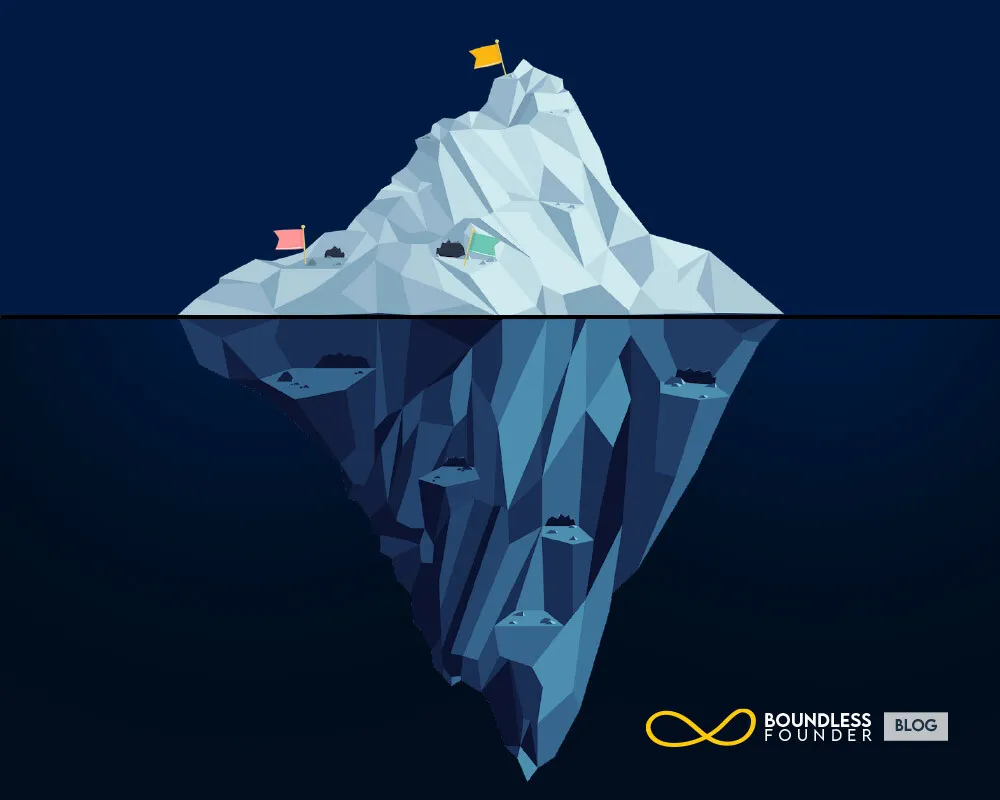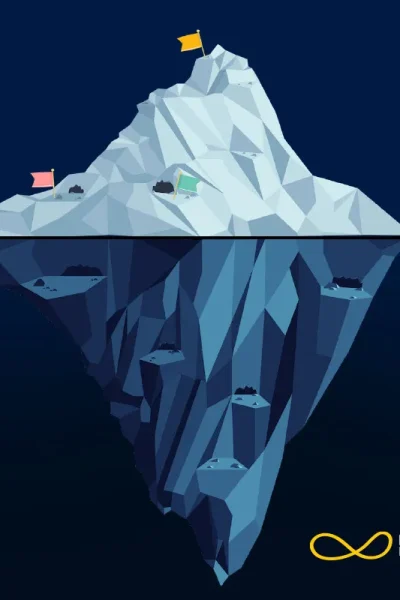Breaking the Myth: What No One Tells You About the Entrepreneurial Journey
Staring at my screen, I froze. Our AWS bill wiped out $65,000 in credits in just twenty days.
We were at our first conference, ready to showcase nine months of work. Our bank account had just $75,000 left. The irony? Our product was supposed to help others save on cloud costs. Yet there I was, utterly paralyzed, unable to process the fact that we had burned through $65,000 in less than three weeks.
This wasn’t in the entrepreneur’s handbook. No one had warned me about moments like these, when you feel physically unable to move forward and your mind spirals into an endless loop of fear and catastrophic thinking.
In the glossy version of entrepreneurship we’re fed through media and success stories, these moments of paralysis don’t exist. But they’re as much a part of the journey as pitch decks and product launches.

The Entrepreneurial Journey: Expectation vs. Reality
We’ve all seen the highlight reels: the founder who built a billion-dollar company from their garage, the overnight success that disrupted an entire industry, and the exit that made headlines. These stories shape our expectations of what entrepreneurship should look like.
But these narratives are dangerously incomplete.
The true entrepreneurial journey is messier, more nuanced, and infinitely more challenging than we’re led to believe. It’s filled with moments of self-doubt, periods of isolation, and countless obstacles that test your business acumen and your mental and emotional resilience.
Research from the University of California Berkeley found that 72% of entrepreneurs self-reported mental health concerns. This isn’t surprising when you consider the unique pressures founders face:
- Constant uncertainty about the future
- Financial stress that affects personal life
- The weight of responsibility for employees and investors
- Isolation in decision-making
- The blurring of personal and professional identities
Understanding these realities isn’t meant to discourage you. Instead, it’s about preparing you for what’s ahead—beyond the success stories and highlight reels.

The Three Phases of the Entrepreneurial Journey
Through my experiences and conversations with countless entrepreneurs, I’ve identified three distinct phases that virtually every founder experiences. Recognizing these phases can help you navigate them more effectively.
Phase 1: The Honeymoon Period
The journey begins with excitement and optimism. You’ve taken the leap, and the possibilities seem endless. This phase is characterized by:
- High energy and enthusiasm
- A singular focus on building and creating
- Confidence in your idea and vision
- The thrill of independence and possibility
During my first months as a full-time entrepreneur, I worked sixteen-hour days, fueled by adrenaline and the belief that I was building something revolutionary. The half-year before diving full-time into my startup was a whirlwind. I was weaving through the intricacies of incorporation, refining our prototype, recruiting freelancers, coding, and detailing our product specifications.
What no one tells you: This phase is temporary. The initial excitement will eventually give way to the realities of building a business, and that’s completely normal.
Phase 2: The Valley of Despair
Eventually, reality sets in. Progress is slower than anticipated. Challenges arise. Doubt creeps in. This phase includes:
- Recognition of how difficult the road ahead truly is
- Confrontation with unexpected obstacles
- Financial pressures are becoming more apparent
- The emotional toll is beginning to mount
- Questioning your decision to become an entrepreneur
This phase hit me hard in my own journey. Six months into building my startup, I faced the harsh reality that our runway was shrinking faster than anticipated. By January, we were getting desperate. My co-founder and I cut our salaries in half to stretch our runway. But raising money before launching our product was proving to be impossible.
What no one tells you: Nearly every successful entrepreneur has gone through this valley. It’s not a sign of failure; it’s a natural part of the journey that requires specific mental and emotional tools.
Phase 3: Sustainable Perseverance
If you make it through the valley, you reach a phase characterized by a more grounded, sustainable approach to entrepreneurship:
- A realistic understanding of the challenges and timeline
- More effective emotional regulation
- Stronger boundaries between work and life
- A focus on sustainable practices rather than constant hustle
- The ability to find meaning in the journey itself, not just the destination
After my AWS bill crisis and several other near-breaking points, I eventually learned to approach entrepreneurship differently. I built mental frameworks to break negative thought loops, established boundaries and reconnected with my purpose beyond business outcomes.
What no one tells you: This phase isn’t about having “made it”—it’s about developing the mindset and tools to continue the journey sustainably. Success becomes redefined as the ability to keep moving forward while maintaining your well-being.

The Hidden Truth: Identity Fusion
One of the most dangerous aspects of entrepreneurship, which rarely gets discussed, is the fusion of one’s identity with one’s company. I call this the “I am my startup” syndrome.
In the early days of my startup, I tied my self-worth entirely to our business results. I felt happy when we met our numbers and depressed when we missed them. This interconnection put me under tremendous pressure to perform and meet business goals every day.
This identity fusion has several dangerous consequences:
- Every business setback feels like a personal failure
- Criticism of your product feels like criticism of your worth
- Decision-making becomes clouded by ego and fear
- Your mental health becomes hostage to business outcomes
- Recovery from failure becomes infinitely harder
During one of the darkest moments of my journey, I thought about my identity should my startup shut down. I had difficulty finding a good description of myself other than “the CEO of a dead company.” I realized that halfway through my entrepreneurial journey, I had let go of everything that defined me as a human.
Breaking the Thoughts-Emotions Loop
Understanding and breaking the thoughts-emotions loop was one of the most powerful tools I discovered for navigating the entrepreneurial journey. This loop occurs when an event triggers thoughts, which create emotions and generate more thoughts, pulling you deeper into a spiral.
After our AWS bill crisis, I was paralyzed by this loop for three weeks. I was caught in a cycle of catastrophic thinking and intense fear that prevented me from taking any constructive action.
Breaking this loop requires a three-step process:
- Recognize the loop: Notice when you’re caught in spiraling thoughts and emotions. Physical signs include racing thoughts, tension, and sleep disturbances.
- Label without judgment: Name the emotions you’re experiencing without judging them as good or bad. “I’m feeling fear and shame right now.”
- Identify triggers: Ask yourself, “What triggered this reaction?” Often, it’s not just the event itself but your interpretation of what it means about you or your future.
When I finally applied this process to our AWS bill situation, I moved from paralysis to problem-solving. I negotiated payment terms with AWS, secured cloud credits from Google, and ultimately turned what seemed like a business-ending crisis into a manageable challenge.
Preparing for the Journey: A Practical Framework
Based on my experiences and the lessons I’ve learned, here’s a framework for preparing yourself mentally and emotionally for the entrepreneurial journey:
1. Define Your “Why” Beyond Success
The entrepreneurs who navigate the journey most successfully are those with a purpose that transcends financial success or status.
Action Step: Write down your answers to these questions:
- What would you still want to achieve even if no one ever knew about it?
- How does your venture connect to your deeper values?
- What impact do you want to have on others through your work?
- What would make this journey worthwhile even if the business ultimately failed?
2. Build Your Support System Before You Need It
Entrepreneurship can be isolating, but it doesn’t have to be lonely. It’s crucial to build a support network proactively.
Action Step: Identify and nurture relationships in these key categories:
- Mentor: Someone who can guide your personal and professional growth
- Advisor: Someone with specific expertise in your industry or business challenges
- Peer Support: Fellow entrepreneurs who understand your unique struggles
- Personal Support: Friends and family who can provide emotional backing
3. Develop Mental Fitness Practices
Just as athletes train their bodies for competition, entrepreneurs must train their minds for resilience.
Action Step: Implement at least two of these practices daily:
- Mindfulness meditation (even 5-10 minutes can make a difference)
- Journaling to process challenges and identify thought patterns
- Physical exercise to maintain the body-mind connection
- Deliberate breaks and recovery periods
- Regular reflection on lessons learned and progress made
4. Create Clear Boundaries
Without intentional boundaries, work can consume every aspect of your life.
Action Step: Establish and communicate clear boundaries:
- Define specific work hours and honor them
- Create physical separation between work and personal spaces
- Establish technology-free times and zones
- Schedule non-negotiable personal activities
- Communicate these boundaries clearly to team members, clients, and family
5. Embrace the Reality of the Journey
Accept that challenges, setbacks, and doubts are standard parts of the entrepreneurial journey, not signs that you’re doing something wrong.
Action Step: Create a “Reality Check” document that:
- Lists the common challenges entrepreneurs face
- Includes quotes or stories from entrepreneurs you admire about their struggles
- Outline your personal coping strategies for difficult times
- Reminds you of your purpose and values
The True Measure of Entrepreneurial Success
As I’ve progressed, I’ve come to redefine what success means as an entrepreneur. It’s not just about exits and valuations—it’s about who you become.
True success includes:
- The ability to maintain your core values while building a business
- Building meaningful relationships with team members, customers, and other entrepreneurs
- Learning and growing through challenges
- Creating impact that aligns with your deeper purpose
- Maintaining your well-being throughout the journey
After going through near-shutdowns, failed acquisitions, and eventual success with my startup, what stays with me isn’t the business outcomes but how the journey transformed me. The resilience, clarity, and wisdom I gained through navigating the challenges continue to serve me in every aspect of life.
Begin Your Journey with Open Eyes

The entrepreneurial path is not for the faint of heart. It will challenge you unexpectedly and force you to confront aspects of yourself you might have preferred to ignore. But with the right mindset, support, and tools, it can be one of the most rewarding journeys you’ll ever undertake.
As you move forward, remember that the value lies in the entire journey—not just the destination. The struggles, the lessons, the growth, and the failures are all part of what makes entrepreneurship so transformative.
Looking back at that moment of paralysis over the AWS bill, I no longer see it as just a crisis. I see it as a critical turning point that forced me to develop the mental resilience and clarity that would ultimately lead to success—both in business and in life.
What challenges are you facing on your entrepreneurial journey? Share your experience in our community, where fellow entrepreneurs are navigating similar paths. Together, we can break through the myths and embrace the reality of entrepreneurship in all its complexity.
Ready to better prepare yourself for the entrepreneurial journey? Download our free “Entrepreneurial Journey Map” workbook to chart your path and develop the mental resilience you’ll need.
You can also dive deeper into entrepreneurial mental resilience in The Inside-Out Entrepreneur, where I share my entire journey and provide comprehensive frameworks for navigating the entrepreneurial path with strength and clarity.











Responses